MSC Project: Analyzing Shilling Attacks Against Recommender Systems
VerifiedAdded on 2023/04/25
|9
|1885
|190
Project
AI Summary
This project proposal investigates the effectiveness of shilling attacks against recommender systems, focusing on the vulnerabilities and potential damage these attacks can inflict. It begins with an introduction to recommender systems, highlighting their role in predicting user preferences on online platforms like Amazon and Netflix. The research aims to determine the extent to which shilling attacks, which involve injecting fake profiles, can compromise these systems. The project outlines research objectives, including analyzing recommender systems, assessing the effectiveness of shilling attacks, and comparing the two. A literature review covers collaborative filtering and content-based filtering techniques, as well as studies scrutinizing shilling attack strategies and detection schemes. The proposed research methodology involves a questionnaire to gather insights from e-commerce users and Netflix viewers, supplemented by a review of prior research on shilling attacks. The project schedule details timelines for literature review, hypothesis formation, questionnaire design, data collection, analysis, and future work exploration. Ethical considerations are addressed, emphasizing the avoidance of unethical data collection practices. The project concludes by reiterating its aim to determine the effectiveness of shilling attacks and contribute to future research in this area; this assignment solution is available on Desklib, where students can find similar documents.

Running head: MSC PROJECT
EFFECTIVENESS OF SHILLING ATTACKS AGAINST RECOMMENDER SYSTEMS
Name of student
Name of university
Author’s note:
EFFECTIVENESS OF SHILLING ATTACKS AGAINST RECOMMENDER SYSTEMS
Name of student
Name of university
Author’s note:
Paraphrase This Document
Need a fresh take? Get an instant paraphrase of this document with our AI Paraphraser
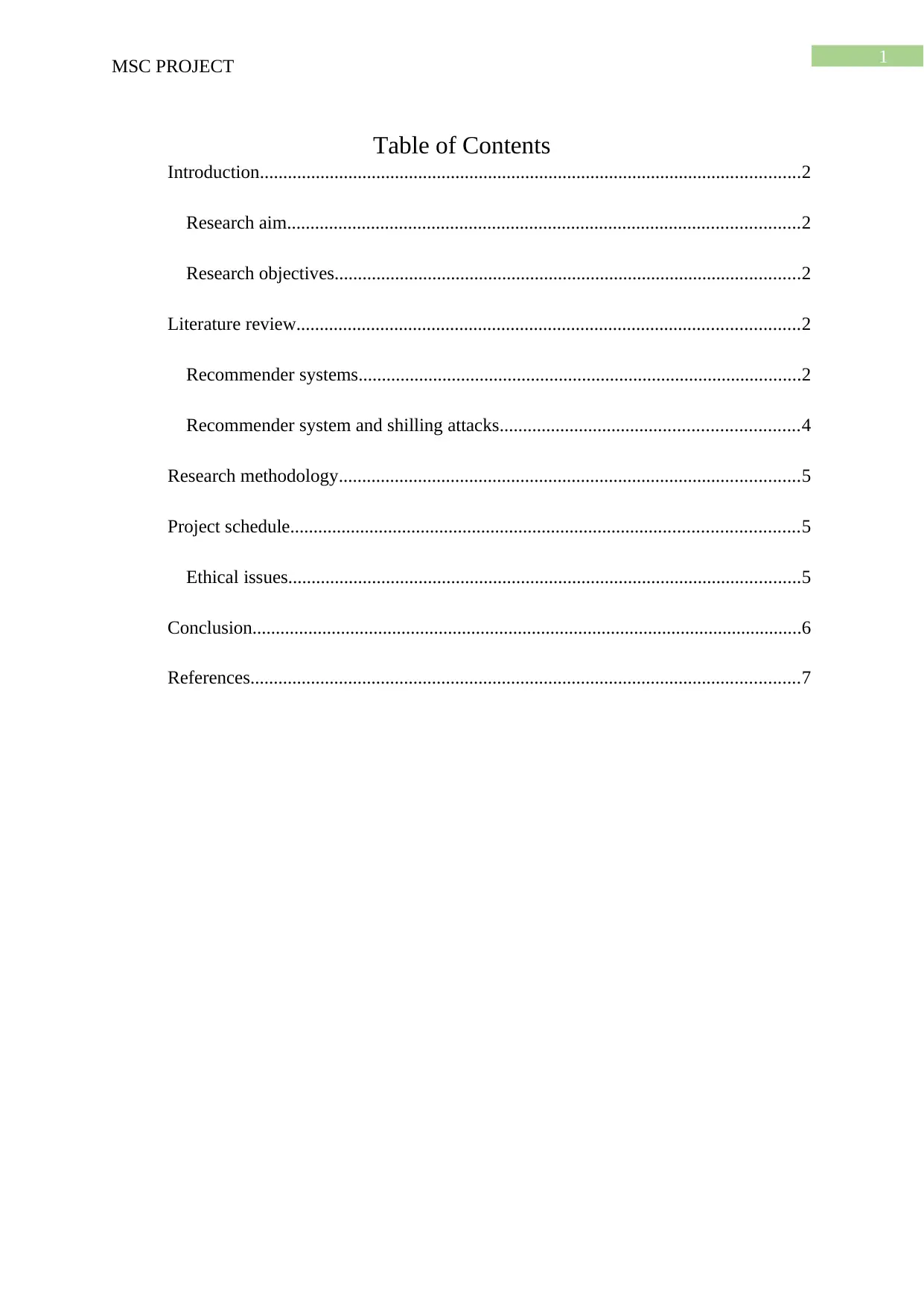
1
MSC PROJECT
Table of Contents
Introduction....................................................................................................................2
Research aim..............................................................................................................2
Research objectives....................................................................................................2
Literature review............................................................................................................2
Recommender systems...............................................................................................2
Recommender system and shilling attacks................................................................4
Research methodology...................................................................................................5
Project schedule.............................................................................................................5
Ethical issues..............................................................................................................5
Conclusion......................................................................................................................6
References......................................................................................................................7
MSC PROJECT
Table of Contents
Introduction....................................................................................................................2
Research aim..............................................................................................................2
Research objectives....................................................................................................2
Literature review............................................................................................................2
Recommender systems...............................................................................................2
Recommender system and shilling attacks................................................................4
Research methodology...................................................................................................5
Project schedule.............................................................................................................5
Ethical issues..............................................................................................................5
Conclusion......................................................................................................................6
References......................................................................................................................7

2
MSC PROJECT
Introduction
This project proposal aims to discuss the effectiveness of the shilling attacks against
recommender systems. A brief discussion of the shilling attacks is provided in this report and
along with the discussion of the recommender system is provided in this report. The research
methodology is provided in this report and at last, this report concludes with an appropriate
conclusion for this report. The recommender systems are used for the predictions of the
preferences of customers when they visit any online platform for buying any product or video
on the internet.
Research aim
The aim of this research is to determine the effectiveness of the effectiveness of the
shilling attacks against any recommender systems. The shilling attacks are carried out in the
recommender systems for damaging these systems of the organisations. The research aims to
investigate the recommender systems and examine it against the shilling attacks.
Research objectives
1. To perform an analysis of the recommender systems
2. To perform an analysis of the shilling attacks and check the effectiveness
3. To perform a comparison between recommender system and shilling attacks
Literature review
Recommender systems
According to Ricci, Rokach and Shapira (2015), the goal of any recommender system
is to provide the meaningful recommendations to any collection of the users for any item or
products that might be of their preference. Some of the examples are the books on the
Amazon platform, movies on Netflix. These features are provided by the strict recommender
MSC PROJECT
Introduction
This project proposal aims to discuss the effectiveness of the shilling attacks against
recommender systems. A brief discussion of the shilling attacks is provided in this report and
along with the discussion of the recommender system is provided in this report. The research
methodology is provided in this report and at last, this report concludes with an appropriate
conclusion for this report. The recommender systems are used for the predictions of the
preferences of customers when they visit any online platform for buying any product or video
on the internet.
Research aim
The aim of this research is to determine the effectiveness of the effectiveness of the
shilling attacks against any recommender systems. The shilling attacks are carried out in the
recommender systems for damaging these systems of the organisations. The research aims to
investigate the recommender systems and examine it against the shilling attacks.
Research objectives
1. To perform an analysis of the recommender systems
2. To perform an analysis of the shilling attacks and check the effectiveness
3. To perform a comparison between recommender system and shilling attacks
Literature review
Recommender systems
According to Ricci, Rokach and Shapira (2015), the goal of any recommender system
is to provide the meaningful recommendations to any collection of the users for any item or
products that might be of their preference. Some of the examples are the books on the
Amazon platform, movies on Netflix. These features are provided by the strict recommender
⊘ This is a preview!⊘
Do you want full access?
Subscribe today to unlock all pages.

Trusted by 1+ million students worldwide

3
MSC PROJECT
systems. The design of the recommendation engines relies on domain and any specific
characteristics of available data. The rating option that is provide by the service providers
offers a tracking of the rating of the scale (Bobadilla et al. 2013). Such any data source
maintains the quality of the interactions among the items and the users. In addition to this, the
system might have the access to any profile attributes that are item-specific or user-specific
like the demographics and the descriptions of the products (Gavalas et al. 2014). The
recommender systems varies in ways that the analysis of the data is done by them for
developing the notions of the affinity among the items and the users that can be used for the
identification of the well matched pairs.
Wang, Wang and Yeung (2015) claims that the systems of collaborative filtering
performs that analysis of the historical interactions while the systems of content based
filtering are dependent on the attributes of the profiles and the hybrid technique tries to
incorporate both of the designs. The introduction of the term collaborative filtering was first
done in relation to the initial recommender system that was used commercially. The
designing of this recommender system was done for recommending the documents that are
drawn from the newsgroups to any collection of users (Borràs, Moreno and Valls 2014). The
main intention was to leverage the collaboration of the society for preventing the users from
receiving inundation by any huge volume of the streaming of documents. The collaborative
filtering that performs the analysis of the data usage across the users for finding the well
matched pairs of the user-item has took over the basic intention of the recommender systems.
The extensive researches were conducted by the availability of the public datasets on web and
the interest that is generated due to the direct connection to the e-commerce. The company
Netflix, which provides the services of DVD rental and online streaming video released the
huge dataset that consist of almost 100 million rating that are provided but the huge number
of users to the thousands of the videos and movies and then the company announced the open
MSC PROJECT
systems. The design of the recommendation engines relies on domain and any specific
characteristics of available data. The rating option that is provide by the service providers
offers a tracking of the rating of the scale (Bobadilla et al. 2013). Such any data source
maintains the quality of the interactions among the items and the users. In addition to this, the
system might have the access to any profile attributes that are item-specific or user-specific
like the demographics and the descriptions of the products (Gavalas et al. 2014). The
recommender systems varies in ways that the analysis of the data is done by them for
developing the notions of the affinity among the items and the users that can be used for the
identification of the well matched pairs.
Wang, Wang and Yeung (2015) claims that the systems of collaborative filtering
performs that analysis of the historical interactions while the systems of content based
filtering are dependent on the attributes of the profiles and the hybrid technique tries to
incorporate both of the designs. The introduction of the term collaborative filtering was first
done in relation to the initial recommender system that was used commercially. The
designing of this recommender system was done for recommending the documents that are
drawn from the newsgroups to any collection of users (Borràs, Moreno and Valls 2014). The
main intention was to leverage the collaboration of the society for preventing the users from
receiving inundation by any huge volume of the streaming of documents. The collaborative
filtering that performs the analysis of the data usage across the users for finding the well
matched pairs of the user-item has took over the basic intention of the recommender systems.
The extensive researches were conducted by the availability of the public datasets on web and
the interest that is generated due to the direct connection to the e-commerce. The company
Netflix, which provides the services of DVD rental and online streaming video released the
huge dataset that consist of almost 100 million rating that are provided but the huge number
of users to the thousands of the videos and movies and then the company announced the open
Paraphrase This Document
Need a fresh take? Get an instant paraphrase of this document with our AI Paraphraser
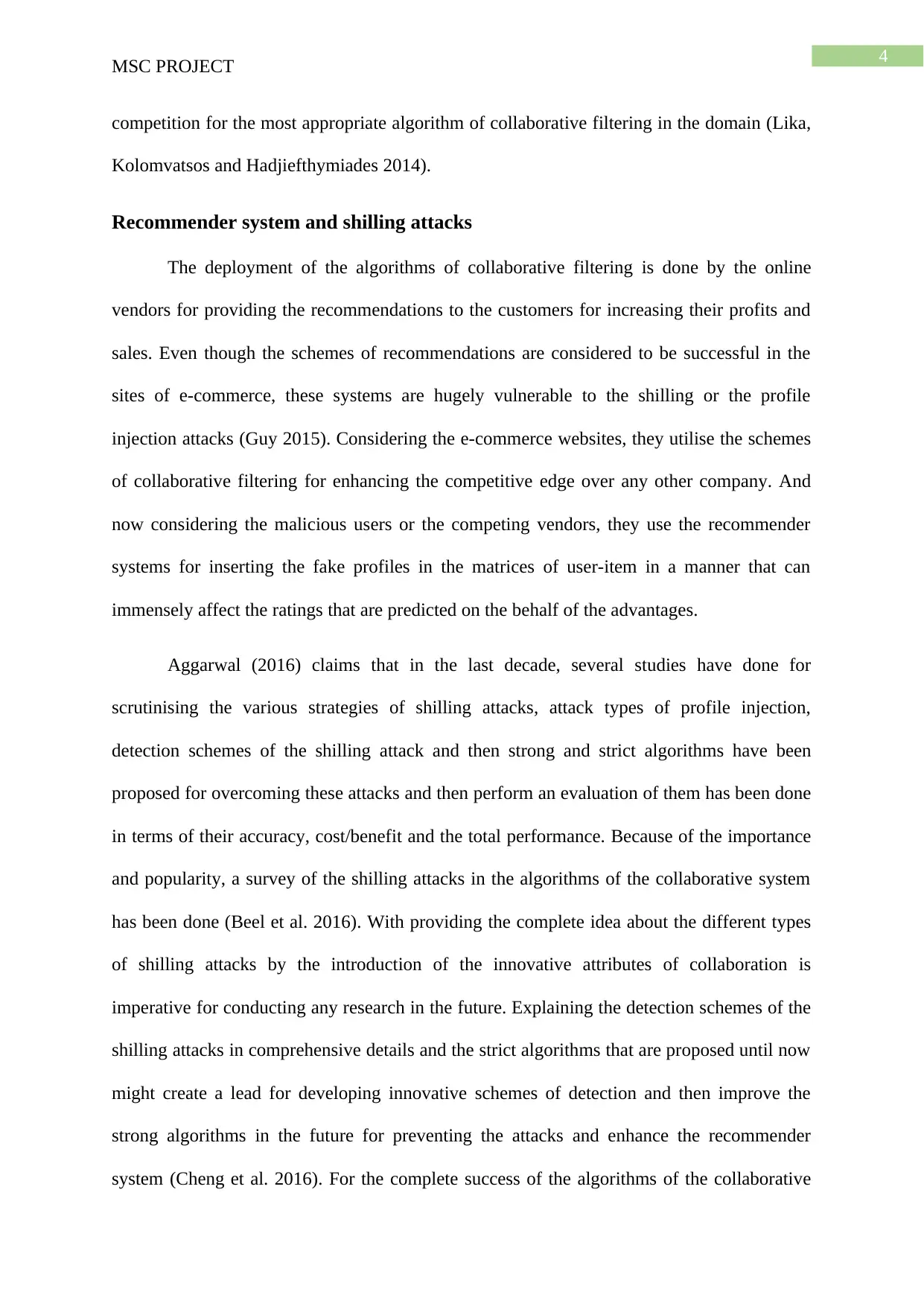
4
MSC PROJECT
competition for the most appropriate algorithm of collaborative filtering in the domain (Lika,
Kolomvatsos and Hadjiefthymiades 2014).
Recommender system and shilling attacks
The deployment of the algorithms of collaborative filtering is done by the online
vendors for providing the recommendations to the customers for increasing their profits and
sales. Even though the schemes of recommendations are considered to be successful in the
sites of e-commerce, these systems are hugely vulnerable to the shilling or the profile
injection attacks (Guy 2015). Considering the e-commerce websites, they utilise the schemes
of collaborative filtering for enhancing the competitive edge over any other company. And
now considering the malicious users or the competing vendors, they use the recommender
systems for inserting the fake profiles in the matrices of user-item in a manner that can
immensely affect the ratings that are predicted on the behalf of the advantages.
Aggarwal (2016) claims that in the last decade, several studies have done for
scrutinising the various strategies of shilling attacks, attack types of profile injection,
detection schemes of the shilling attack and then strong and strict algorithms have been
proposed for overcoming these attacks and then perform an evaluation of them has been done
in terms of their accuracy, cost/benefit and the total performance. Because of the importance
and popularity, a survey of the shilling attacks in the algorithms of the collaborative system
has been done (Beel et al. 2016). With providing the complete idea about the different types
of shilling attacks by the introduction of the innovative attributes of collaboration is
imperative for conducting any research in the future. Explaining the detection schemes of the
shilling attacks in comprehensive details and the strict algorithms that are proposed until now
might create a lead for developing innovative schemes of detection and then improve the
strong algorithms in the future for preventing the attacks and enhance the recommender
system (Cheng et al. 2016). For the complete success of the algorithms of the collaborative
MSC PROJECT
competition for the most appropriate algorithm of collaborative filtering in the domain (Lika,
Kolomvatsos and Hadjiefthymiades 2014).
Recommender system and shilling attacks
The deployment of the algorithms of collaborative filtering is done by the online
vendors for providing the recommendations to the customers for increasing their profits and
sales. Even though the schemes of recommendations are considered to be successful in the
sites of e-commerce, these systems are hugely vulnerable to the shilling or the profile
injection attacks (Guy 2015). Considering the e-commerce websites, they utilise the schemes
of collaborative filtering for enhancing the competitive edge over any other company. And
now considering the malicious users or the competing vendors, they use the recommender
systems for inserting the fake profiles in the matrices of user-item in a manner that can
immensely affect the ratings that are predicted on the behalf of the advantages.
Aggarwal (2016) claims that in the last decade, several studies have done for
scrutinising the various strategies of shilling attacks, attack types of profile injection,
detection schemes of the shilling attack and then strong and strict algorithms have been
proposed for overcoming these attacks and then perform an evaluation of them has been done
in terms of their accuracy, cost/benefit and the total performance. Because of the importance
and popularity, a survey of the shilling attacks in the algorithms of the collaborative system
has been done (Beel et al. 2016). With providing the complete idea about the different types
of shilling attacks by the introduction of the innovative attributes of collaboration is
imperative for conducting any research in the future. Explaining the detection schemes of the
shilling attacks in comprehensive details and the strict algorithms that are proposed until now
might create a lead for developing innovative schemes of detection and then improve the
strong algorithms in the future for preventing the attacks and enhance the recommender
system (Cheng et al. 2016). For the complete success of the algorithms of the collaborative
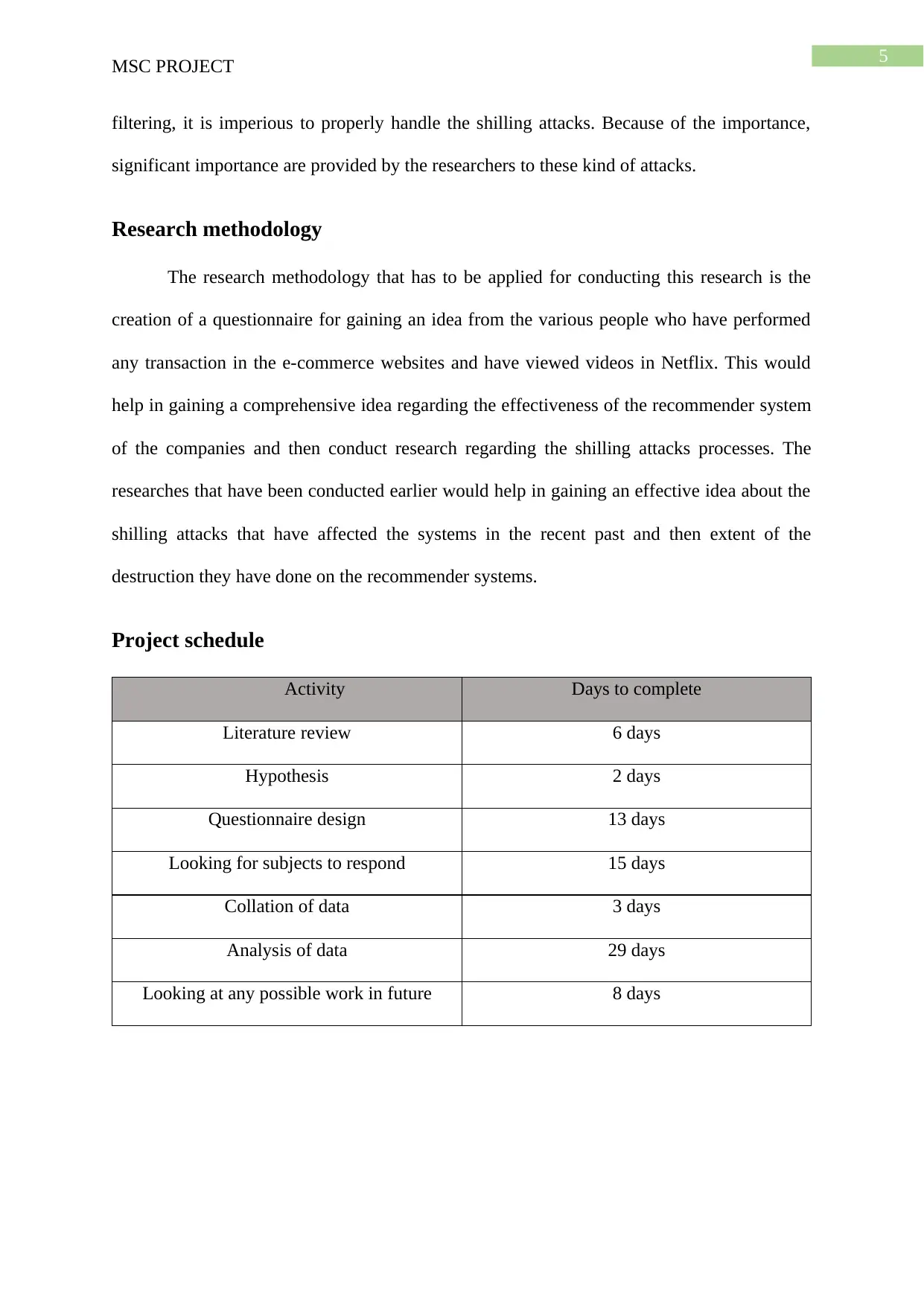
5
MSC PROJECT
filtering, it is imperious to properly handle the shilling attacks. Because of the importance,
significant importance are provided by the researchers to these kind of attacks.
Research methodology
The research methodology that has to be applied for conducting this research is the
creation of a questionnaire for gaining an idea from the various people who have performed
any transaction in the e-commerce websites and have viewed videos in Netflix. This would
help in gaining a comprehensive idea regarding the effectiveness of the recommender system
of the companies and then conduct research regarding the shilling attacks processes. The
researches that have been conducted earlier would help in gaining an effective idea about the
shilling attacks that have affected the systems in the recent past and then extent of the
destruction they have done on the recommender systems.
Project schedule
Activity Days to complete
Literature review 6 days
Hypothesis 2 days
Questionnaire design 13 days
Looking for subjects to respond 15 days
Collation of data 3 days
Analysis of data 29 days
Looking at any possible work in future 8 days
MSC PROJECT
filtering, it is imperious to properly handle the shilling attacks. Because of the importance,
significant importance are provided by the researchers to these kind of attacks.
Research methodology
The research methodology that has to be applied for conducting this research is the
creation of a questionnaire for gaining an idea from the various people who have performed
any transaction in the e-commerce websites and have viewed videos in Netflix. This would
help in gaining a comprehensive idea regarding the effectiveness of the recommender system
of the companies and then conduct research regarding the shilling attacks processes. The
researches that have been conducted earlier would help in gaining an effective idea about the
shilling attacks that have affected the systems in the recent past and then extent of the
destruction they have done on the recommender systems.
Project schedule
Activity Days to complete
Literature review 6 days
Hypothesis 2 days
Questionnaire design 13 days
Looking for subjects to respond 15 days
Collation of data 3 days
Analysis of data 29 days
Looking at any possible work in future 8 days
⊘ This is a preview!⊘
Do you want full access?
Subscribe today to unlock all pages.

Trusted by 1+ million students worldwide
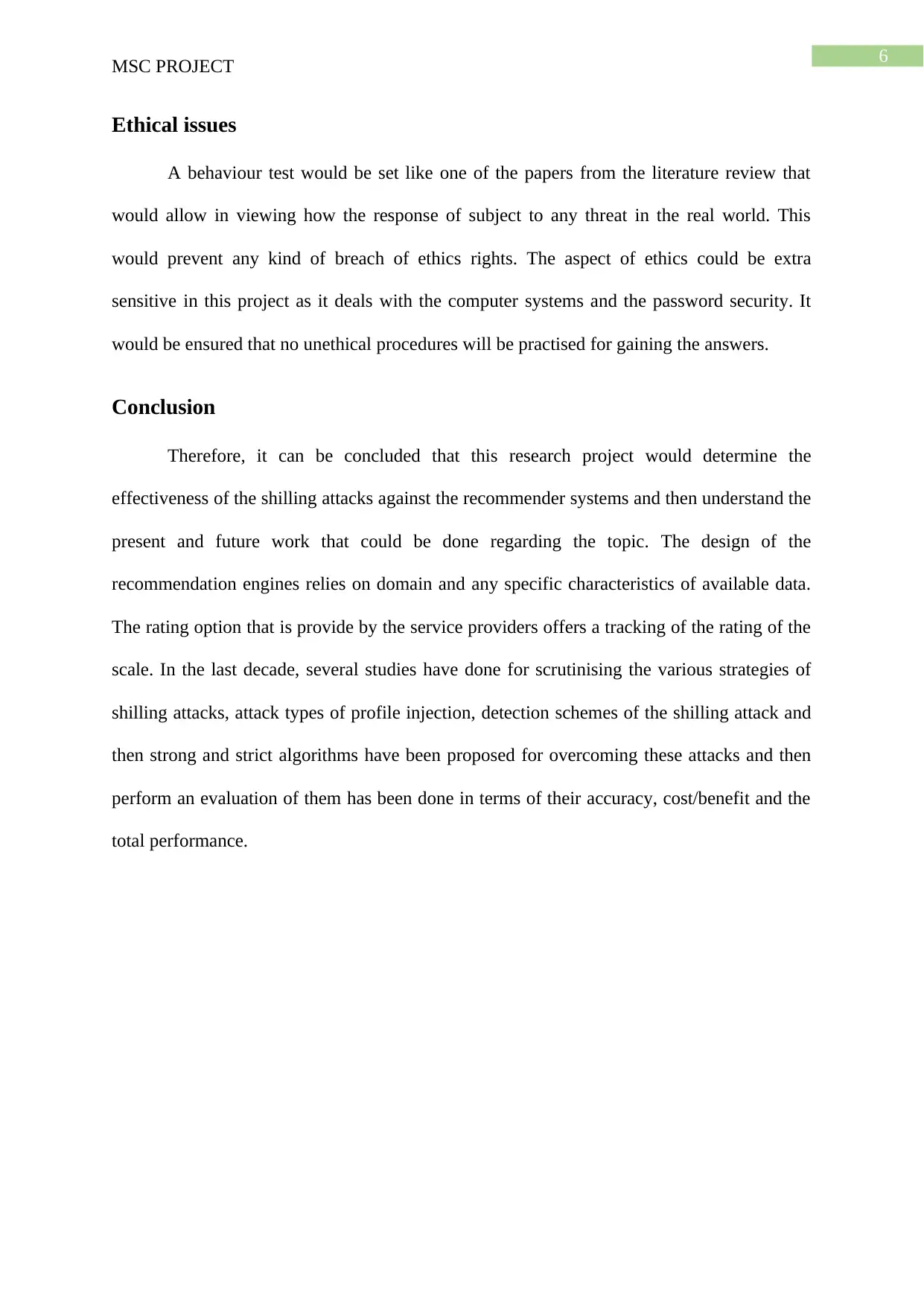
6
MSC PROJECT
Ethical issues
A behaviour test would be set like one of the papers from the literature review that
would allow in viewing how the response of subject to any threat in the real world. This
would prevent any kind of breach of ethics rights. The aspect of ethics could be extra
sensitive in this project as it deals with the computer systems and the password security. It
would be ensured that no unethical procedures will be practised for gaining the answers.
Conclusion
Therefore, it can be concluded that this research project would determine the
effectiveness of the shilling attacks against the recommender systems and then understand the
present and future work that could be done regarding the topic. The design of the
recommendation engines relies on domain and any specific characteristics of available data.
The rating option that is provide by the service providers offers a tracking of the rating of the
scale. In the last decade, several studies have done for scrutinising the various strategies of
shilling attacks, attack types of profile injection, detection schemes of the shilling attack and
then strong and strict algorithms have been proposed for overcoming these attacks and then
perform an evaluation of them has been done in terms of their accuracy, cost/benefit and the
total performance.
MSC PROJECT
Ethical issues
A behaviour test would be set like one of the papers from the literature review that
would allow in viewing how the response of subject to any threat in the real world. This
would prevent any kind of breach of ethics rights. The aspect of ethics could be extra
sensitive in this project as it deals with the computer systems and the password security. It
would be ensured that no unethical procedures will be practised for gaining the answers.
Conclusion
Therefore, it can be concluded that this research project would determine the
effectiveness of the shilling attacks against the recommender systems and then understand the
present and future work that could be done regarding the topic. The design of the
recommendation engines relies on domain and any specific characteristics of available data.
The rating option that is provide by the service providers offers a tracking of the rating of the
scale. In the last decade, several studies have done for scrutinising the various strategies of
shilling attacks, attack types of profile injection, detection schemes of the shilling attack and
then strong and strict algorithms have been proposed for overcoming these attacks and then
perform an evaluation of them has been done in terms of their accuracy, cost/benefit and the
total performance.
Paraphrase This Document
Need a fresh take? Get an instant paraphrase of this document with our AI Paraphraser
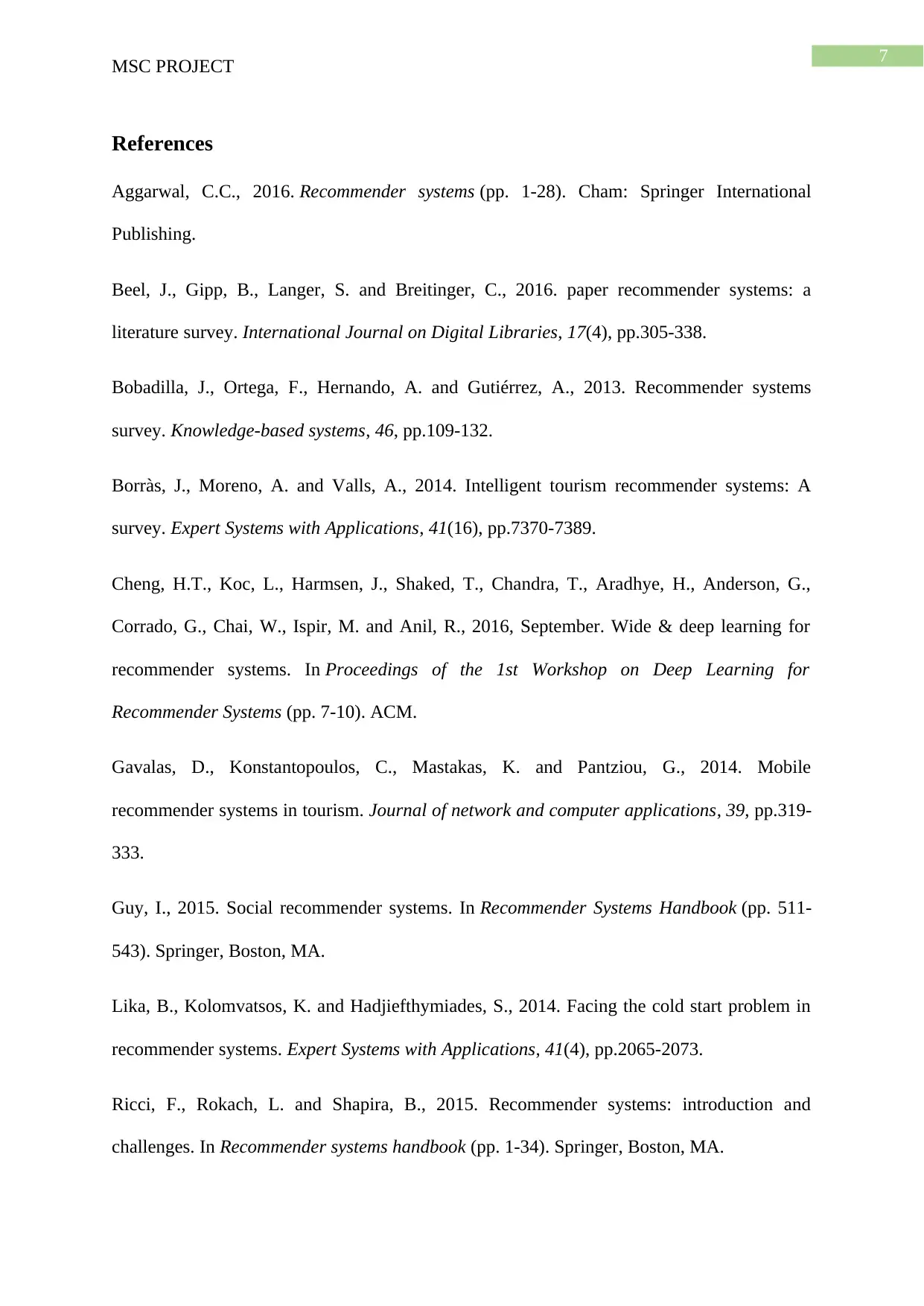
7
MSC PROJECT
References
Aggarwal, C.C., 2016. Recommender systems (pp. 1-28). Cham: Springer International
Publishing.
Beel, J., Gipp, B., Langer, S. and Breitinger, C., 2016. paper recommender systems: a
literature survey. International Journal on Digital Libraries, 17(4), pp.305-338.
Bobadilla, J., Ortega, F., Hernando, A. and Gutiérrez, A., 2013. Recommender systems
survey. Knowledge-based systems, 46, pp.109-132.
Borràs, J., Moreno, A. and Valls, A., 2014. Intelligent tourism recommender systems: A
survey. Expert Systems with Applications, 41(16), pp.7370-7389.
Cheng, H.T., Koc, L., Harmsen, J., Shaked, T., Chandra, T., Aradhye, H., Anderson, G.,
Corrado, G., Chai, W., Ispir, M. and Anil, R., 2016, September. Wide & deep learning for
recommender systems. In Proceedings of the 1st Workshop on Deep Learning for
Recommender Systems (pp. 7-10). ACM.
Gavalas, D., Konstantopoulos, C., Mastakas, K. and Pantziou, G., 2014. Mobile
recommender systems in tourism. Journal of network and computer applications, 39, pp.319-
333.
Guy, I., 2015. Social recommender systems. In Recommender Systems Handbook (pp. 511-
543). Springer, Boston, MA.
Lika, B., Kolomvatsos, K. and Hadjiefthymiades, S., 2014. Facing the cold start problem in
recommender systems. Expert Systems with Applications, 41(4), pp.2065-2073.
Ricci, F., Rokach, L. and Shapira, B., 2015. Recommender systems: introduction and
challenges. In Recommender systems handbook (pp. 1-34). Springer, Boston, MA.
MSC PROJECT
References
Aggarwal, C.C., 2016. Recommender systems (pp. 1-28). Cham: Springer International
Publishing.
Beel, J., Gipp, B., Langer, S. and Breitinger, C., 2016. paper recommender systems: a
literature survey. International Journal on Digital Libraries, 17(4), pp.305-338.
Bobadilla, J., Ortega, F., Hernando, A. and Gutiérrez, A., 2013. Recommender systems
survey. Knowledge-based systems, 46, pp.109-132.
Borràs, J., Moreno, A. and Valls, A., 2014. Intelligent tourism recommender systems: A
survey. Expert Systems with Applications, 41(16), pp.7370-7389.
Cheng, H.T., Koc, L., Harmsen, J., Shaked, T., Chandra, T., Aradhye, H., Anderson, G.,
Corrado, G., Chai, W., Ispir, M. and Anil, R., 2016, September. Wide & deep learning for
recommender systems. In Proceedings of the 1st Workshop on Deep Learning for
Recommender Systems (pp. 7-10). ACM.
Gavalas, D., Konstantopoulos, C., Mastakas, K. and Pantziou, G., 2014. Mobile
recommender systems in tourism. Journal of network and computer applications, 39, pp.319-
333.
Guy, I., 2015. Social recommender systems. In Recommender Systems Handbook (pp. 511-
543). Springer, Boston, MA.
Lika, B., Kolomvatsos, K. and Hadjiefthymiades, S., 2014. Facing the cold start problem in
recommender systems. Expert Systems with Applications, 41(4), pp.2065-2073.
Ricci, F., Rokach, L. and Shapira, B., 2015. Recommender systems: introduction and
challenges. In Recommender systems handbook (pp. 1-34). Springer, Boston, MA.
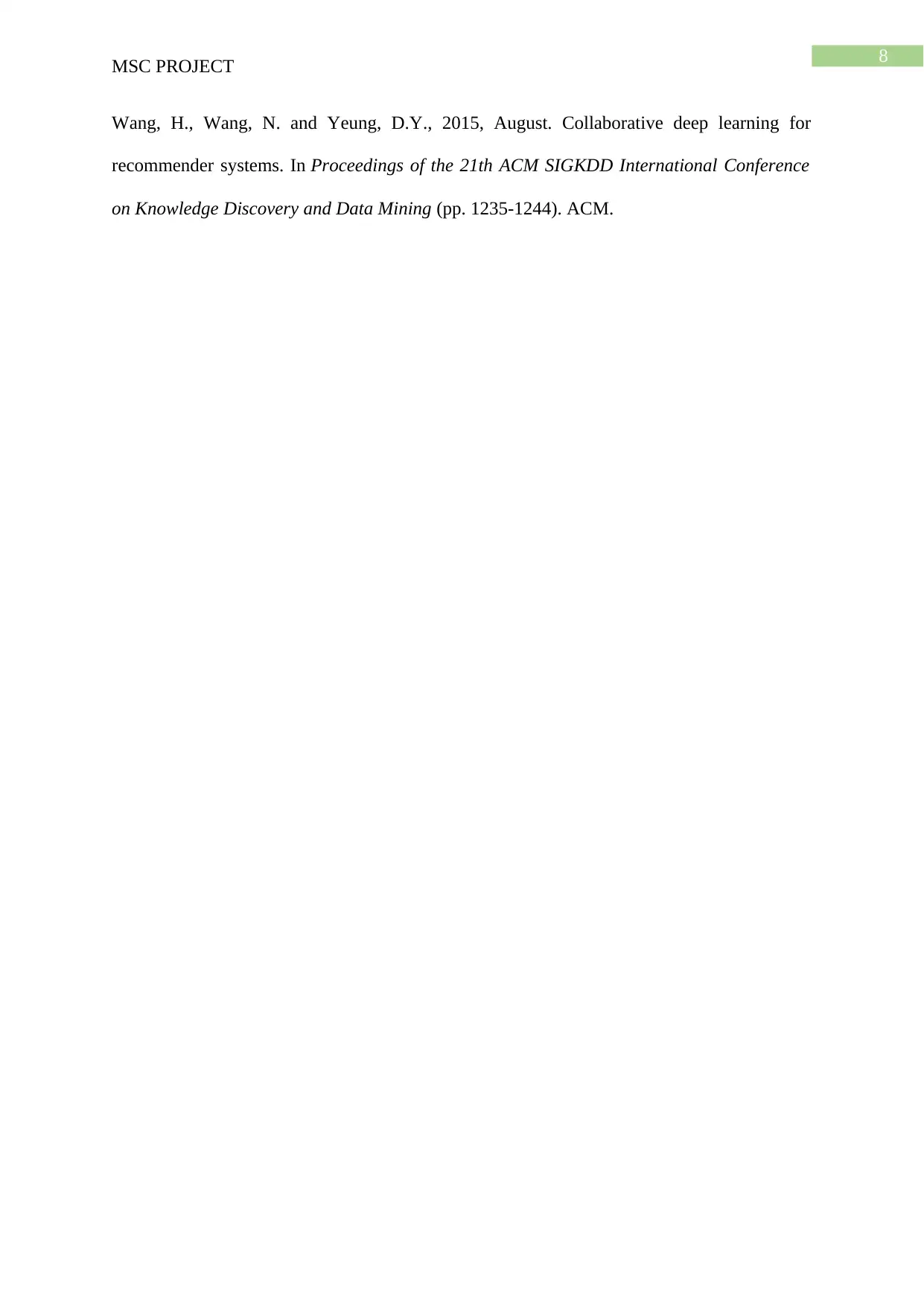
8
MSC PROJECT
Wang, H., Wang, N. and Yeung, D.Y., 2015, August. Collaborative deep learning for
recommender systems. In Proceedings of the 21th ACM SIGKDD International Conference
on Knowledge Discovery and Data Mining (pp. 1235-1244). ACM.
MSC PROJECT
Wang, H., Wang, N. and Yeung, D.Y., 2015, August. Collaborative deep learning for
recommender systems. In Proceedings of the 21th ACM SIGKDD International Conference
on Knowledge Discovery and Data Mining (pp. 1235-1244). ACM.
⊘ This is a preview!⊘
Do you want full access?
Subscribe today to unlock all pages.

Trusted by 1+ million students worldwide
1 out of 9
Related Documents
Your All-in-One AI-Powered Toolkit for Academic Success.
+13062052269
info@desklib.com
Available 24*7 on WhatsApp / Email
![[object Object]](/_next/static/media/star-bottom.7253800d.svg)
Unlock your academic potential
Copyright © 2020–2025 A2Z Services. All Rights Reserved. Developed and managed by ZUCOL.





